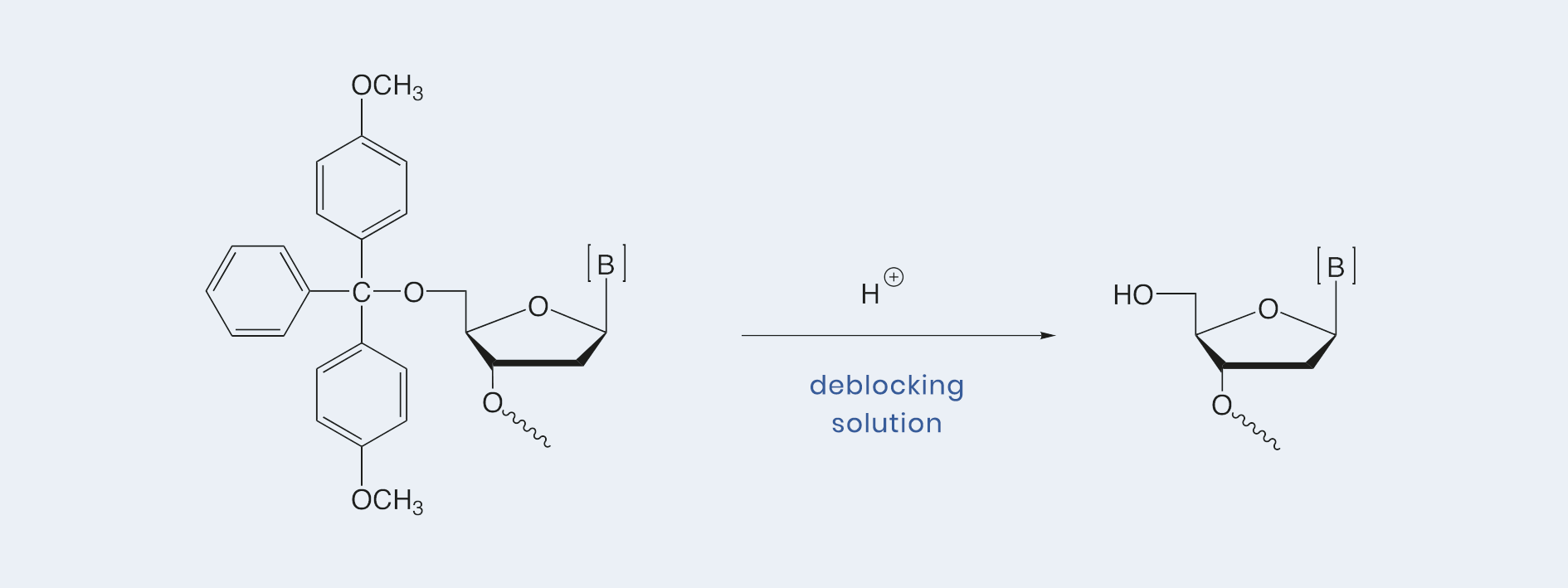emp BIOTECH Product Inquiry
Thank you for your inquiry. A member of our team will get back to you shortly.

Bulk requests
This product is available in manufacturing scale (bulk) volumes and formulations.
Please use the button below to request information about bulk volume availability and customized formulations.
Send e-mail
Deblocking / Detritylation
 Deblocking solutions, used for the cleavage of the 5‘-DMTr group at the last building block of nucleotide chain, can consist either of dichloroacetic or trichloroacetic acid in dichloromethane or toluene. Our Hyacinth Deblocking solution (3 % dichloroacetic acid in toluene at < 30 ppm water) is applicable for the syntheses of high quality, large scale oligonucleotides.
Deblocking solutions, used for the cleavage of the 5‘-DMTr group at the last building block of nucleotide chain, can consist either of dichloroacetic or trichloroacetic acid in dichloromethane or toluene. Our Hyacinth Deblocking solution (3 % dichloroacetic acid in toluene at < 30 ppm water) is applicable for the syntheses of high quality, large scale oligonucleotides.





Hazard Classifications
Flammable liquid, Category 2 (Flam. Liq. 2)
Aspiration hazard, Category 1 (Asp. Tox. 1)
Skin irritation, Category 2 (Skin Irrit. 2)
Serious eye damage/eye irritation, Category 1 (Eye Dam. 1)
Specific target organ toxicity - single exposure, Category 3 (STOT SE 3)
Carcinogenicity, Category 2 (Carc. 2)
Reproductive toxicity, Category 1B (Repr. 1B)
Specific target organ toxicity - repeated exposure, Category 2 (STOT RE 2)
Hazardous to the aquatic environment, Category 3 (Aquatic Chronic 3)
Hazard Statements
| H225 | Highly flammable liquid and vapour. |
| H304 | May be fatal if swallowed and enters airways. |
| H315 | Causes skin irritation. |
| H318 | Causes serious eye damage. |
| H336 | May cause drowsiness or dizziness. |
| H351 | Suspected of causing cancer <state route of exposure if it is conclusively proven that no other routes of exposure cause the hazard>. |
| H360FD | May damage fertility. May damage the unborn child. |
| H373 | May cause damage to organs <or state all organs affected, if known> through prolonged or repeated exposure <state route of exposure if it is conclusively proven that no other routes of exposure cause the hazard>. |
| H410 | Very toxic to aquatic life with long lasting effects. |
Precautionairy Statements
| P210 | Keep away from heat, hot surfaces, sparks, open flames and other ignition sources. No smoking. |
| P273 | Avoid release to the environment. |
| P280 | Wear protective gloves/protective clothing/eye protection/face protection. |
| P301+P310 | IF SWALLOWED: Immediately call a POISON CENTER/doctor/…. |
| P305+P351+P338 | IF IN EYES: Rinse cautiously with water for several minutes. Remove contact lenses, if present and easy to do. Continue rinsing. |
| P331 | Do NOT induce vomiting. |
Signal Word
Danger
WGK
WGK 2
Storage Class Code
3 - Flammable liquids
ADR, RID (road and railroad)
UN2924 FLAMMABLE LIQUID, CORROSIVE, N.O.S. (Solution of Dichloroacetic Acid in Toluene), 3(8), II
IATA-DGR (transport by air)
UN2924 FLAMMABLE LIQUID, CORROSIVE, N.O.S. (Solution of Dichloroacetic Acid in Toluene), 3(8), II
IMDG-Code (transport by sea)
UN2924 FLAMMABLE LIQUID, CORROSIVE, N.O.S. (Solution of Dichloroacetic Acid in Toluene), 3(8), II





Gefahreneinstufungen
Entzündbare Flüssigkeiten, Kategorie 2 (Flam. Liq. 2)
Aspirationsgefahr, Kategorie 1 (Asp. Tox. 1)
Ätz-/Reizwirkung auf die Haut, Kategorie 2 (Skin Irrit. 2)
Schwere Augenschädigung/Augenreizung, Kategorie 1 (Eye Dam. 1)
Spezifische Zielorgan-Toxizität (einmalige Exposition), Kategorie 3 (STOT SE 3)
Karzinogenität, Kategorie 2 (Carc. 2)
Reproduktionstoxizität, Kategorie 1B (Repr. 1B)
Spezifische Zielorgan-Toxizität (wiederholte Exposition), Kategorie 2 (STOT RE 2)
Gewässergefährdend, Kategorie 3 (Aquatic Chronic 3)
Gefahrenhinweise - H-Sätze
| H225 | Flüssigkeit und Dampf leicht entzündbar. |
| H304 | Kann bei Verschlucken und Eindringen in die Atemwege tödlich sein. |
| H315 | Verursacht Hautreizungen. |
| H318 | Verursacht schwere Augenschäden |
| H336 | Kann Schläfrigkeit und Benommenheit verursachen. |
| H351 | Kann vermutlich Krebs erzeugen (Expositionsweg angeben, sofern schlüssig belegt ist, dass diese Gefahr bei keinem anderen Expositionsweg besteht). |
| H360FD | Kann die Fruchtbarkeit beeinträchtigen. Kann das Kind im Mutterleib schädigen. |
| H373 | Kann die Organe schädigen (alle betroffenen Organe nennen) bei längerer oder wiederholter Exposition (Expositionsweg angeben, wenn schlüssig belegt ist, dass diese Gefahr bei keinem anderen Expositionsweg besteht). |
| H410 | Sehr giftig für Wasserorganismen, mit langfristiger Wirkung. |
Sicherheitshinweise - P-Sätze
| P210 | Von Hitze, heißen Oberflächen, Funken, offenen Flammen und anderen Zündquellen fernhalten. Nicht rauchen. |
| P273 | Freisetzung in die Umwelt vermeiden. |
| P280 | Schutzhandschuhe/Schutzkleidung/Augenschutz/Gesichtsschutz/Gehörschutz/… tragen. |
| P301+P310 | BEI VERSCHLUCKEN: Sofort GIFTINFORMATIONSZENTRUM/Arzt/… anrufen. |
| P305+P351+P338 | BEI KONTAKT MIT DEN AUGEN: Einige Minuten lang behutsam mit Wasser spülen. Eventuell vorhandene Kontaktlinsen nach Möglichkeit entfernen. Weiter spülen. |
| P331 | KEIN Erbrechen herbeiführen. |
Signalwort
Gefahr
WGK
WGK 2
Lagerklasse
3 - Entzündliche flüssige Stoffe
ADR, RID (Strasse und Eisenbahn)
UN2924 FLAMMABLE LIQUID, CORROSIVE, N.O.S. (Solution of Dichloroacetic Acid in Toluene), 3(8), II
IATA-DGR (Luftverkehr)
UN2924 FLAMMABLE LIQUID, CORROSIVE, N.O.S. (Solution of Dichloroacetic Acid in Toluene), 3(8), II
IMDG (Seeschiffverkehr)
UN2924 FLAMMABLE LIQUID, CORROSIVE, N.O.S. (Solution of Dichloroacetic Acid in Toluene), 3(8), II
